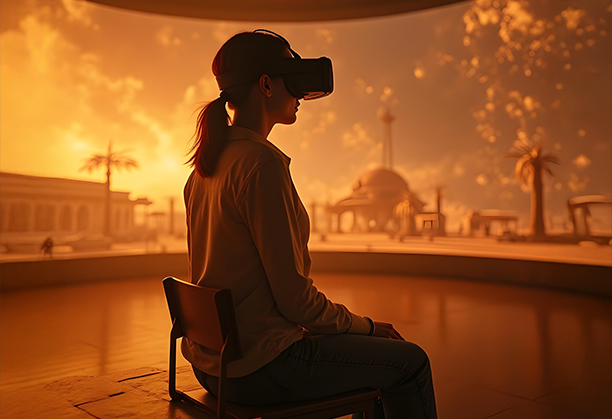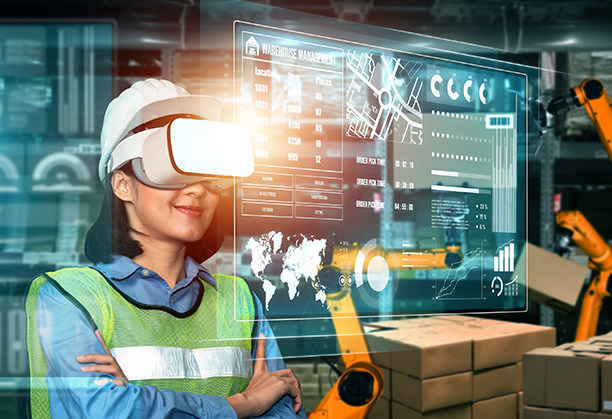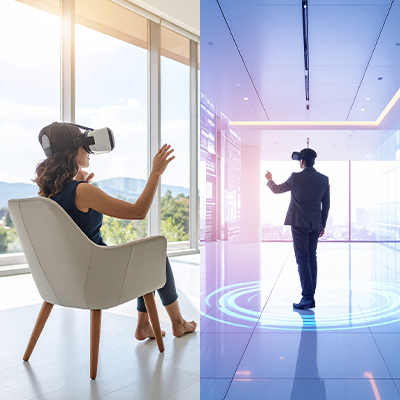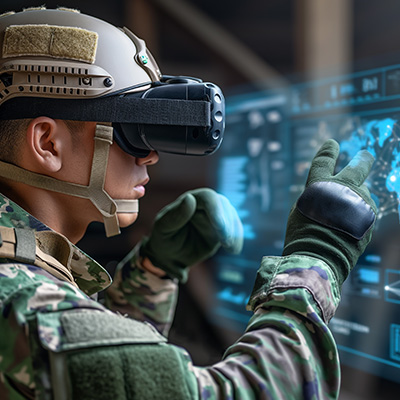When you wear a VR headset, the possibility seems endless. You can either be the one experiencing everything firsthand, or you can experience everything from afar. That’s the difference between 3DoF and 6DoF; it is like the distinction between looking through a keyhole and walking through the door itself, i.e., between being an observer pressed against glass and turning into a participant who can slide under virtual branches, lean around digital corners, and reach out to touch objects that feel intriguingly real.
Understanding these degrees of freedom influences every decision about VR technology, whether creating content, choosing equipment, or organizing a project. The decision impacts user experience, development complexity, and budget issues, determining whether your virtual environment feels like a faraway movie or an alternate reality.
What Are Degrees of Freedom?
Degrees of freedom are the independent ways that something can move through space in three dimensions. Your head naturally moves six different ways. Rotation is used in three movements: nodding up and down, left and right, and rolling/tilting from side to side. The latter three involves: moving forward and backward, stepping left and right, and moving up and down.
These six movements are the foundation of normal human mobility. VR systems track various combinations of these movements to achieve different levels of immersion. The frequency of movements detected by a system determines whether a user is passively observing or actively participating in virtual environments.
3DoF VR
You can look in any direction you want but remain stationary in virtual space. Consider sitting in a fixed chair and rotating your head to look around a room; you get a full view while remaining stationary.
Internal sensors such as gyroscopes monitor head rotation and adapt the virtual view accordingly. This produces a “look around” experience that is ideal for 360-degree films, virtual tours, and educational content in which actual movement is not necessary.
The technology thrives in certain applications. Virtual museum tours enable you to explore exhibits from various perspectives without having to go around them. Training presentations become more interesting when participants are able to look about organically while learning. This immersive viewing experience helps educational information by eliminating the need for sophisticated interactions or movement mechanics.
Advantages of 3DoF
- Lower hardware costs and complexity
- Reduced motion sickness
- Easier setup and deployment
- Better battery life for mobile devices
- Suitable for confined spaces

6DoF VR
6DoF headsets track both head rotation and body movement. You can walk around virtual objects, duck under obstacles, and lean in to examine details closely. This creates true presence in virtual environments.
The technology uses cameras and sensors to monitor your position in space. Advanced software maps your environment and tracks your movements within it. Some systems use cameras on the headset itself, while others rely on external sensors placed around your play area.
This complete tracking enables natural interactions. Medical students can practice surgery by moving their hands naturally. Architects can walk through building designs and examine spaces from different perspectives. Gamers can dodge attacks and reach for objects intuitively.
Benefits of 6DoF
- Complete presence and immersion
- Natural hand and body interactions
- Realistic spatial relationships
- Enhanced learning and retention
- Future-proof technology investment
Content Creation: Two Different Approaches
The type of content you can create and consume differs significantly between 3DoF and 6DoF systems, each requiring different production approaches and technical considerations.
360-Degree Video Production (3DoF)
360-degree video content involves capturing real-world scenes using specialized camera rigs that record the entire spherical view around a fixed point. The production process includes:
- Filming: Using cameras like Samsung Gear 360 or professional rigs
- Stitching: Combining multiple camera feeds into seamless spherical video
- Post-production: Editing and optimizing for VR viewing platforms
This content is perfect for 3DoF experiences, allowing viewers to look around but not move within the captured scene.
Interactive 3D VR Development (6DoF)
3D VR content creation involves building interactive virtual environments using game engines like Unity or Unreal Engine. The development process includes:
- 3D modeling: Creating virtual objects and environments
- Texturing and lighting: Adding realistic surfaces and atmospheric effects
- Programming: Implementing interactions and user behaviors
- Optimization: Ensuring smooth performance across different hardware
This content leverages 6DoF capabilities, enabling users to explore and interact with virtual worlds naturally.
![]()
Choosing the Right Technology
Choose 6DoF when interaction is essential. Medical training, architectural walkthroughs, and collaborative workspaces benefit from full movement tracking. The technology is also better for applications where users need to examine objects closely or manipulate virtual tools.
Budget plays a role, too. 3DoF development is generally more straightforward and cost-effective. 6DoF projects require more resources, both for development and hardware. The complexity can increase development time by two to three times.
Consider your deployment scenario. 3DoF works well for large groups and classroom settings. The simpler setup means less technical support. 6DoF typically requires dedicated hardware and more space, making it better suited for individual or small group experiences.
| Technical Aspect | 3DoF Development | 6DoF Development |
| Processing Power | Less than 5% of device resources | 15-25% of processing power |
| Rendering Pipeline | Simple spherical projection | Complex 3D environments with physics |
| Memory Requirements | 3-4GB RAM | 8GB+ RAM |
| Graphics Requirements | Integrated graphics compatible | Dedicated GPU with 6GB+ VRAM |
| Battery Consumption | 40-60% less power usage | High power consumption |
| Thermal Management | Minimal heat generation | Critical thermal management needed |
| Development Timeline | Standard timeline | 2-3x longer development |
| Team Size | Smaller technical teams | Multidisciplinary teams required |
| Quality Assurance | Straightforward testing | Extensive testing across configurations |
| Platform Compatibility | Universal (smartphones, web browsers) | Platform-specific (Meta Quest, PlayStation VR) |
| Deployment Options | WebXR, mobile apps, streaming | Dedicated VR hardware required |
Ready to transform your vision into an immersive VR experience?
Why Juego neXR for VR Development?
At Juego neXR, we are aware that deciding between 3DoF and 6DoF is a strategic choice that will affect your project as a whole. Together, you and our team of VR engineers, designers, and strategists will determine the ideal balance between functionality, immersion, and cost for your particular needs.
We’ve guided clients through diverse challenges: educational content that must perform consistently across hundreds of devices, and advanced VR training simulations that demand maximum immersion. Our approach encompasses the complete development cycle, from initial concept through deployment and ongoing support.
Conclusion
The choice between 3DoF and 6DoF for your particular project is the goal of virtual reality, not selecting a winner. Understanding your use case, audience, and technological needs is essential to success. Whether your VR experience meets or exceeds users’ expectations will largely depend on the degrees of freedom you select. This decision influences everything that comes next, whether you’re starting off with virtual reality or creating ground-breaking applications.
Frequently Asked Questions
No, 6DoF tracking cannot be added to 3DoF headphones. Essentially, other hardware components are needed for this functionality, such as extra sensors, cameras, or external tracking systems that aren’t included in 3DoF devices. Retrofitting is not feasible because the tracking technology is included in the hardware architecture during manufacturing.
Motion sickness occurs in both, although the causes are different. Because there is no mismatch between physical and virtual movement in 3DoF, motion sickness is usually reduced. 6DoF can cause more motion sickness as users adjust to traversing virtual spaces; however, contemporary headsets have considerably decreased this due to improved tracking precision and display technology.
Yes, 6DoF headsets handle 3DoF content seamlessly. The headset simply disables its positional tracking capabilities when viewing 360-degree videos or other 3DoF content. This backward compatibility makes 6DoF headsets versatile for consuming various content types without compromising performance.
Yes, 6DoF VR raises additional safety concerns because users move physically through space. This includes providing enough play areas, removing obstructions, creating guardian boundary systems, and remaining mindful of others nearby. 3DoF users are often seated or immobile, which eliminates these physical safety concerns.
6DoF development costs significantly more due to increased complexity in 3D environment creation, interaction programming, spatial audio implementation, and extensive testing across hardware configurations. 3DoF development, particularly for 360-degree video content, proves more cost-effective but may require specialized filming equipment. The cost difference typically ranges from 2-5 times higher for 6DoF, depending on project scope.
Revolutionize the future of business with Juego neXR
Related Posts
Share this Article:
Our Offices

India
Bangalore
GR Grand Plaza, 2nd Floor, JP Nagar, 6th Phase, Bangalore – 560 078

KSA
Jeddah
St Idris Square, 4036 Helmi Koutbi, Al Zahra, Jeddah 23425, Saudi Arabia
Follow Us On:
© 2025 Juego neXR. All Rights Reserved.




